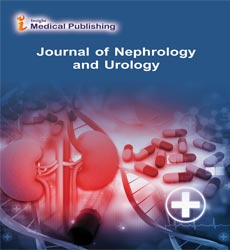A Brief Note on Effect of COVID-19 on Kidney Transplantation
Guirat Louati*
Department of Urology, Hedi Hospital, Heidelberg, Germany
- *Corresponding Author:
- Guirat Louati
Departmetn of Urology,
Hedi Hospital,
Heidelbegr,
Germany,
Tel: +2652256719;
E-mail: Guiratl45@yahoo.com
Received Date: December 01, 2021; Accepted Date: December 15, 2021; Published Date: December 22, 2021
Citation: Guirat L (2021) A Brief Note on Effect of COVID-19 on Kidney Transplantation. J Nephrol Urol Vol:5 No:5:25.
Description
The solid organ transplantation has dramatically modified since the COVID-19 pandemic outspread [1]. The transplant personnel has enforced many changes in response to frequently altered circumstances with the aims of protective personal protecting instrumentality, maintaining hospital capability throughout an anticipated surge in COVID-19 cases and minimizing the chance of virus transmission. There is enormous uncertainty concerning the adequacy of obtainable SARS-CoV-2 testing and considerations concerning the potential risk of transmitting a virulent sickness to heavily immunological disorder transplant recipients and otherwise healthy live donors.
Although the Centres for health care and health care services classified solid organ transplantation as a 3b level procedure, which means that it shouldn't be deferred, the bulk of transplant centres within the USA have reduced their numbers of urinary organ transplant procedures in response to the COVID-19 pandemic. In late March 2020, a survey of 88 North American Nation transplant establishments reportable that 71.8% had utterly suspended live donor urinary organ transplantation and 84% had enforced restrictions for deceased donor urinary organ transplantation [2]. The quantity of recent registrants for the deceased donor urinary organ transplant has ablated by 80%, seemingly reflective of delays within the analysis of urinary organ transplant candidates [3]. With the goal of aiding transplant centres in creating troublesome selections, researchers have developed a simulation calculator that uses the characteristics of transplant candidates and regional COVID-19 parameters to spot people who might doubtless profit the foremost from urinary organ transplantation throughout the pandemic [4]. The chance of donor transmitted COVID-19 infection in urinary organ transplant recipients remains unknown. The shortage of reports of such transmission suggests that the chance has been mitigated by the reduced variety of transplants and speedy implementation of donor screening protocols by Organ Procural Organizations (OPOs).
The semi-permanent management of urinary organ transplant recipient’s needs on-going analysis of the tolerability of immunosuppressant’s still as frequent laboratory assessment of drug levels and transplant perform. Most transplant centres have enforced policies to obviate physical interaction of urinary organ transplant recipients with the general public and healthcare employees, and such policies ought to continue within the reopening phases. Example, changing clinic visits into telemedicine and minimizing reserve laboratory testing. Additionally, protocol biopsies ought to be postponed and also the risks and advantages of playacting for-cause urinary organ transplant biopsies ought to be rigorously weighed. In some cases, protocol biopsies might doubtless get replaced with noninvasive medicine like quantification of donor-derived no cellular deoxyribonucleic acid and genomic tools.
In a few months, the COVID-19 pandemic has profound adjustments in kidney transplantation. This influence has been felt at the stages of man or woman affected person care, transplant centres, OPOs and country wide policies. Consequences such as extra mortality on the waiting listing and diminished referrals for transplant comparison will proceed to have an influence lengthy after the pandemic has sub-sided. We hope that classes discovered from this pandemic will enable us to guard our sufferers greater effectively, devise rational insurance policies for transplant choices and set up structures of care in the match of every other such crisis.
References
- Alasfar S, Avery RK (2020) The impact of COVID-19 on kidney transplantation. Nat Rev Nephrol 16:568-569.
- Boyarsky BJ, Chiang TPY, Werbel WA, Durand CM, Avery RK, et al. (2020) Early impact of COVID-19 on transplant center practices and policies in the United States. Am J Transplant 20:1809-1818.
- Boyarsky BJ, Werbel WA, Durand CM, Avery RK, Jackson KR, et al. (2020) Early national and center-level changes to kidney transplantation in the United States during COVID-19 epidemic. Am J Transplant 20:3131-3139.
- Massie AB, Boyarsky BJ, Werbel WA, Bae S, Eric K, et al. (2020) Identifying scenarios of benefit or harm from kidney transplantation during the COVID-19 pandemic: A stochastic simulation and machine learning study. Am J Transplant 20:2997-3007.
Open Access Journals
- Aquaculture & Veterinary Science
- Chemistry & Chemical Sciences
- Clinical Sciences
- Engineering
- General Science
- Genetics & Molecular Biology
- Health Care & Nursing
- Immunology & Microbiology
- Materials Science
- Mathematics & Physics
- Medical Sciences
- Neurology & Psychiatry
- Oncology & Cancer Science
- Pharmaceutical Sciences
